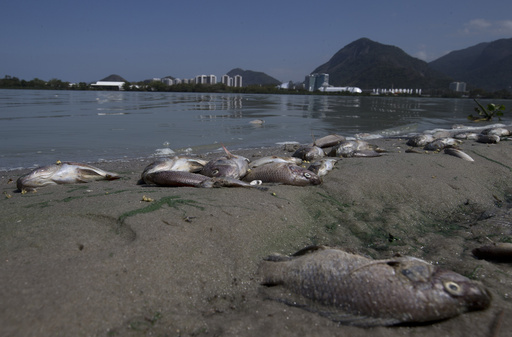RIO DE JANEIRO (AP) — When Rio de Janeiro hosted the Olympics in 2016, videos of the extensive lagoon complex surrounding the Olympic Park were everywhere. Long polluted by sewage and garbage, many hoped the surge of investments tied to the international sports event would restore its waterways. That didn’t happen.
Eight years later, a private concessionaire is working to recover the aquatic ecosystem in Rio’s western zone. The project aims to remove enough silt and filth from the Barra and Jacarepagua lagoons to fill 920 Olympic-size swimming pools. Dredging started in late April and is expected to take three years, according to Igua, the company that recently assumed control of water and sewage in the city’s western neighborhoods.
Real estate development in western Rio has exploded over the last half century. Areas of mangroves and coastal forests were filled in and paved over to make way for gated communities and up-market apartment complexes. They were required by law to treat their sewage, but many shut off their systems at night to save money, according to Márcio Santa Rosa, who was in charge of the 2016 Olympic bid’s environmental management and sustainability plan. Local watersheds also received untreated waste from informal working-class neighborhoods.
Ahead of the 2016 games, Santa Rosa’s office committed to restoring the lagoon complex and the state government carried out extensive studies. But it got bogged down in bureaucracy, he said.
“There was a dispute between (state and federal) public prosecutors, and the project didn’t move forward,” Santa Rosa, who now coordinates sustainable sea economy and bay management at Rio’s environmental secretariat, told The Associated Press by phone. “Incredibly, we lost the opportunity to do this cleanup work during the Olympics.”
In 2021, Rio’s state government split water distribution and sewage collection off from its utility, Cedae, and auctioned four, 35-year concession areas. Winning bidders can lose their concessions for failing to meet their contractually stipulated goal of boosting sewage collection and treatment to 90% by 2033, and have specific environmental requirements. Igua has to clean up the lagoon complex.
Expectations before the concession were “the worst possible,” said Mario Moscatelli, a biologist and expert in coastal ecosystems, and longtime critic of the state’s incapacity to stem the flow of sewage into waterways.
“We had the Pan-American Games, the Olympic Games, the World Cup, thousands of Olympic promises and environmental legacies that ended up not happening,” he said.
But Moscatelli says he has witnessed lagoon conditions improve while working for Igua as a consultant. He compared it to a patient that, once terminally ill, is now back on its feet and walking.
Igua must invest 2.7 billion Brazilian reais ($510 million) in its concession area, including 250 million reais to clean the lagoon complex. Besides the dredging, Igua is restoring the channels between the lagoons and the Atlantic Ocean, installing collectors to prevent the discharge of untreated sewage, and recovering native mangrove forests.
Reversing decades of degradation and an absence of watershed management will still take time.
“It’s a medium- to long-term path. We still can’t evaluate or verify any gains, because all these actions need to be implemented,” said Lucas Arrosti, Igua’s operational director. “Only after they’re completed will we start to see significant changes in water quality.”
___
Sá Pessoa reported from São Paulo.
___
Follow AP’s coverage of Latin America and the Caribbean at https://apnews.com/hub/latin-america
This website uses cookies so that we can provide you with the best user experience possible. Cookie information is stored in your browser and performs functions such as recognising you when you return to our website and helping our team to understand which sections of the website you find most interesting and useful.
